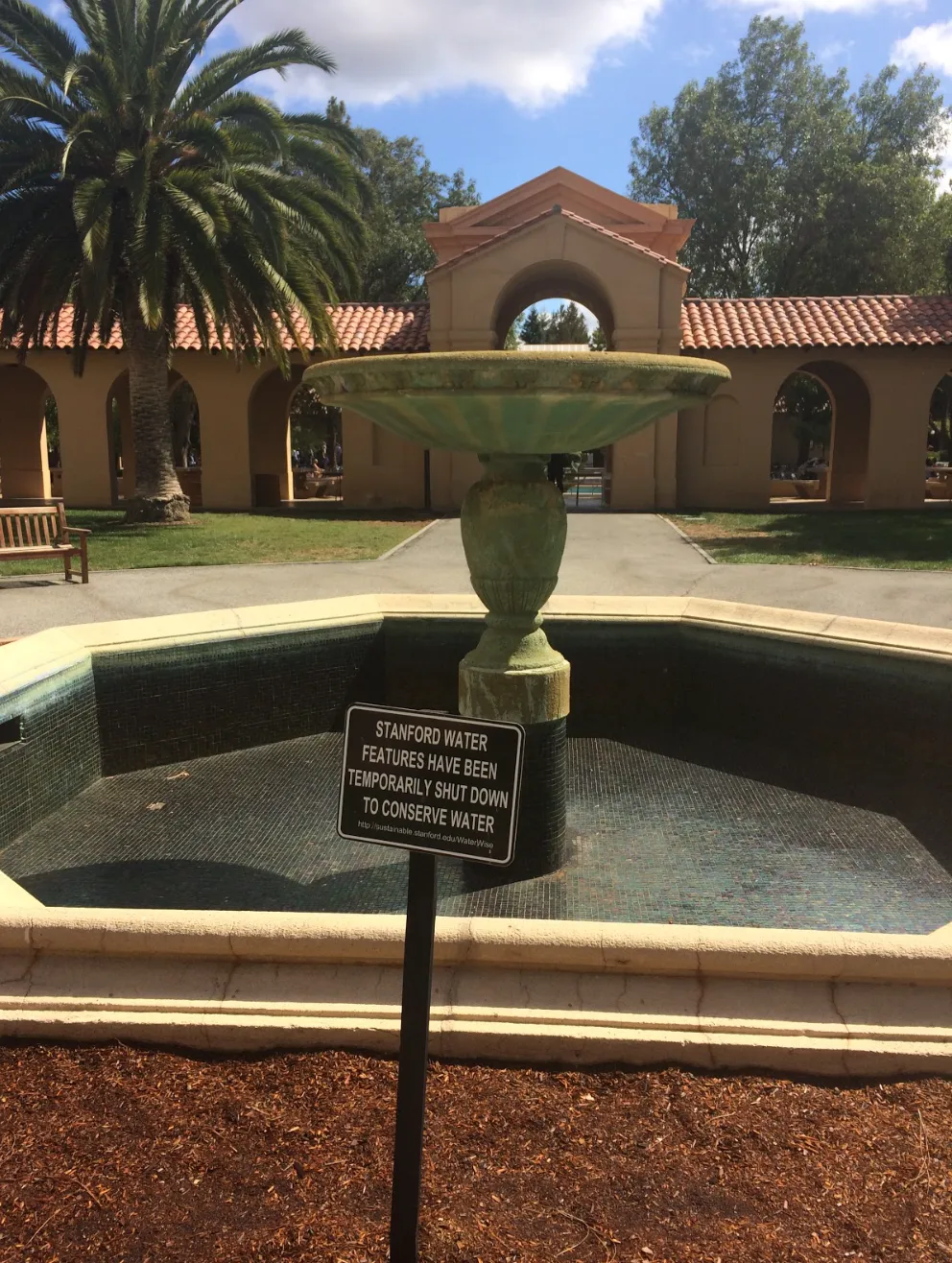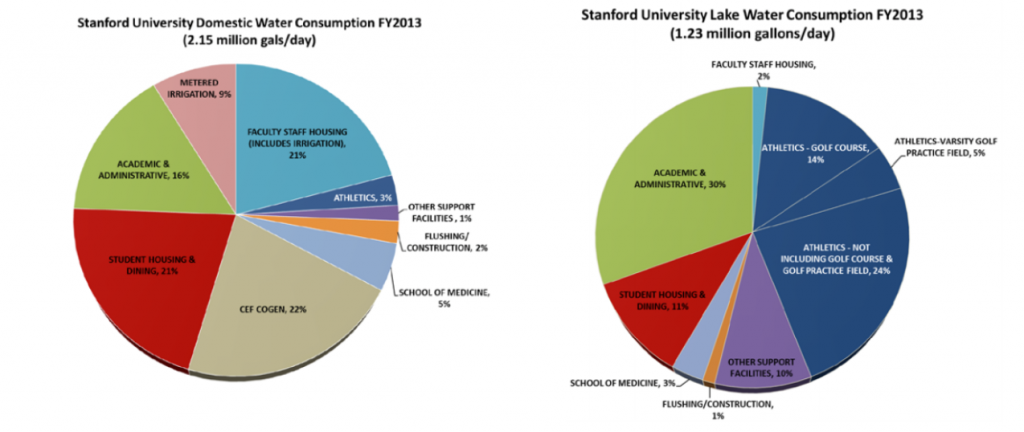Table of Contents
“SERIOUS DROUGHT. HELP SAVE WATER.” announces an electric sign in bright red lettering as I drive down Highway 280 toward Stanford. There are 700 such signs across California, put up in response to Governor Jerry Brown’s January 2014 declaration of a state of emergency due to the drought. The present California dry spell is the worst in 100 years, and over 80% of California is now classified as being in a state of “extreme drought.”
Stanford appears to be making every effort to comply. The University encourages students and faculty to cut down by handing out 5-minute shower timers, lower pressure shower heads, bathroom aerators, and tablets that can detect toilet leaks. It has experimented with smart sprinklers that can detect weather patterns to determine when, how often, and how much to water lawns. Provost John Etchemendy announced that lawn watering with “domestic” potable water is restricted to just twice a week, and the 25 water fountains on campus have been drained since last winter. Barton Thompson, Director of the Stanford Woods Institute for the Environment, said, “If the University has to, it will [let lawns turn brown]. As the drought gets longer and longer, we must resort to stronger and stronger measures to conserve.”
**** ****
**** ****
It seems rather odd, then, that all of Stanford’s 1.3 million square feet of green areas are, well, green. At what point would the drought be bad enough that Stanford would let its fields turn brown? Does all its rhetoric about conservation amount to little more than a disingenuous PR campaign?
The empty fountains and shower timers are real, of course. But so is the water that Stanford’s 2,700 sprinklers use to keep our fields greens. Stanford’s decision to irrigate the green spaces on campus is irresponsible. It may also be illegal.
In July, the State Water Resources Control Board instituted a number of emergency drought regulations. Among them was a restriction on using domestic water to irrigate lawns. According to California law, it is now illegal to use “potable water to water outdoor landscapes in a manner that causes runoff to adjacent property, non-irrigated areas, private and public walkways, roadways, parking lots or structures.”
Unfortunately, Stanford does not seem to be abiding by this law. For example, when the University waters Levin Field and the Faisan courtyard, there is significant runoff onto adjacent sidewalks, walkways, and the asphalt basketball court. The University is not adhering to its own self-imposed policy, either. Etchemendy has pledged that fields will only be irrigated between 7pm and 7am, but the other day as I walked to class, the sprinkler system was diligently showering water onto Levin Field at 9:55am.
**** ****
The provost has encouraged members of the Stanford community to report any violations of the regulations to the Land, Buildings & Real Estate facilities customer service center. I called them to report the runoff that I had noticed. They told me that was a request that needed to be directed to Housing. I reported the violation to Housing, and then asked whether they intended or expected there to be water runoff. “I can’t answer that right now,” said the Housing staff member. He then told me that he would need to send someone over to look at it. Whether the runoff was acceptable would depend on how much was running off and where. He said someone would be out tomorrow to assess the situation and asked for my number so they could call me.
I never received a phone call, and to the best of my knowledge no one came out to examine the sprinklers.
I called a week later to see whether there was a record made of my request. The man I spoke to told me he wasn’t sure. I asked why no one had come to investigate. He wasn’t sure about that, either. I decided to repeat my complaint in the hope that this time something would be done. He seemed confused when I described the problem as “runoff onto the walkways.”
“Ok is there an actual leak?” he said. “Or is the sprinkler head broken?”
If the University is using non-potable water on these features, the runoff is not technically illegal. However, evidence indicates that much of the water Stanford uses on its lawns is in fact potable. Last year irrigation constituted 9% of Stanford’s domestic water consumption, while Faculty Staff Housing, which includes irrigation, was responsible for another 21% of water use. Stanford uses non-potable water on athletic fields, but not on other green areas. Indeed, Etchemendy’s letter mentions the “summer irrigation season” as being “when much of our potable water is consumed.” In other words, watering of green areas is responsible for using up a lot of valuable, drinkable water. Etchemendy then goes on to say that “to comply with… regulations we must limit irrigation using the campus domestic water system to two days per week.” The grassy areas outside the Faisan Courtyard, as well as Levin Field, are watered just twice a week — the limit for irrigation using potable water. It is highly unlikely this is a mere coincidence. Rather, it is clear that Stanford is watering its substantial non-athletic green areas with potable water.
Watering fields with potable water is, in and of itself, not illegal. However, for a school that claims to be a leader in environmental responsibility, this unnecessary use of valuable water resources is deplorable. This wastefulness is especially hypocritical considering that Stanford encourages its students to take measures as drastic as “Put[ting] less ice in your drink” in order to save water. Stanford holds its students to the highest standards when it comes to conserving water. It ought to hold itself to those same standards. Green lawns are certainly more aesthetically pleasing than brown ones, but they are hardly a requirement for going to classes, learning, and participating in extracurricular activities. We let our fountains run dry and drained Lake Lag — so why not let our fields turn brown? Or, at the very least, why not water them with non-potable water, as we do with the athletic fields?
**** ****
Runoff onto walkways, however, is very clearly illegal. And it’s happening. During the two nights a week when Levin Field is watered, lights are mirrored in the pool of water that sits atop the basketball court. The walkways outside my dormitory, too, glisten with the reflection of the lights. It is almost pretty until you remember that it is illegal.
Meanwhile a thousand people across the state of California are without drinking water. We need to do better.






